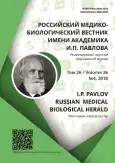A study of the effect of complexes of 3d-metal ions with gluconic acid on synthesis of cytokines in experimental immunodeficiency
- Authors: Knyazeva O.A.1, Urazaeva S.I.1
-
Affiliations:
- Federal State Budgetary Educational Institution of Higher Education "Bashkir State Medical University" of the Ministry of Healthcare of the Russian Federation
- Issue: Vol 26, No 4 (2018)
- Pages: 459-465
- Section: Original study
- URL: https://journals.rcsi.science/pavlovj/article/view/10840
- DOI: https://doi.org/10.23888/PAVLOVJ2018264459-465
- ID: 10840
Cite item
Abstract
Aim. Evaluation of the influence of synthesized gluconates of 3d-metals on production of cytokines in blood serum of mice with experimental immunodeficiency.
Materials and Methods. The effect of complex compounds of bivalent 3d-metals (Mn, Fe, Co, Cu, Zn) with glucuronic acid on production of cytokines: interleukin (IL)-1β, IL-6, interferon-γ (IFN-γ), tumor necrosis factor-α (TNF-α) in blood serum of mice with experimental immunodeficiency induced by a single intraperitoneal administration of cyclophosphamide at the dose of 50 mg/kg was studied. 3d-Metal gluconates (10-2mol/l) were orally introduced for comparison with immunostimulatory drug «Licopid®» and calcium gluconate (doses were calculated according to the instructions) daily for two weeks, starting from the second day after the injection of cyclophosphamide. Levels of cytokines were determined by immunoenzyme analysis.
Results. On the 16th day after the induction of immunodeficiency, levels of cytokines in blood serum of mice decreased: IL-1β – by 75.0%, IL-6 – by 65.2%, IFN-γ – by 61.6%, TNF-α –by 55.6% (p<0.05). Stimulatory effect of gluconates of 3d-metals on synthesis of cytokines depended on the used metal: the effect of MnGl, FeGl, CoGl, CuGl was lower than of licopid. ZnGl produced a weaker effect than licopid only on synthesis of IL-6, and equal effect on secretion of IL-1β and IFN-γ, and the highest effect on TNF-α (p<0.05 for all comparisons). Calcium gluconate did not produce any significant effect on the content of cytokines.
Conclusion. The obtained results show a significant role of 3d-metals in maintenance of immune homeostasis, which, taking into account the literature data, may be explained by their action through activation of the nuclear transcription factor NF-κB which controls expression of cytokines.
Keywords
Full Text
##article.viewOnOriginalSite##About the authors
Olga A. Knyazeva
Federal State Budgetary Educational Institution of Higher Education "Bashkir State Medical University" of the Ministry of Healthcare of the Russian Federation
Author for correspondence.
Email: olga_knyazeva@list.ru
ORCID iD: 0000-0002-1753-4784
SPIN-code: 3828-3978
ResearcherId: V-2621-2018
PhD in Biological of Sciences, Associate Professor, Professor of the Department of Biological Chemistry
Russian Federation, 450008, Ufa, Lenin street, 3Sabina I. Urazaeva
Federal State Budgetary Educational Institution of Higher Education "Bashkir State Medical University" of the Ministry of Healthcare of the Russian Federation
Email: vestnik@rzgmu.ru
ORCID iD: 0000-0002-6417-8671
SPIN-code: 9239-6795
ResearcherId: V-2626-2018
Assistant of the Department of Faculty Therapy
Russian Federation, 450008, Ufa, Lenin street, 3References
- Baldo BA. Side Effects of Cytokines Approved for Therapy. Drug Safety. 2014;37(11):921-43. doi:10. 1007/s40264-014-0226-z
- Konkina IG, Ivanov SP, Knyazeva OA, et al. Physicochemical properties and pharmacological activity of Mn(II), Fe(II), Co(II), Cu(II), and Zn(II) gluconates. Pharmaceutical Chemistry Journal. 2002;36(1):18-21. (In Russ). doi: 10.30906/0023-1134-2002-36-1-18-21
- Wang W, Nag SA, Zhang R. Targeting the NFκB Signaling Pathways for Breast Cancer Prevention and Therapy. Current Medicinal Chemistry. 2015; 22(2):264-89. doi: 10.2174/0929867321666141106 124315
- Knyazeva OA, Urazaeva SI, Konkina IG, et al. Antiimmunosuppressive action of 3d-metal gluconates in experimental immunodeficiency. Kazan Medical Journal. 2018;99(2):255-59. (In Russ). doi: 10.17816/KMJ2018-255
- Kumari N, Dwarakanath BS, Das A, et al. Role of interleukin-6 in cancer progression and therapeutic resistance. Tumor Biology. 2016;37(9):11553-72. doi: 10.1007/s13277-016-5098-7
- West NR, McCuaig S, Franchini F, et al. Emerging cytokine networks in colorectal cancer. Nature Reviews Immunology. 2015;15(10):615-29. doi:10. 1038/nri3896
- Kotiyal S, Bhattacharya S. Breast cancer stem cells, EMT and therapeutic targets. Biochemical and Biophysical Research Communications. 2014;453(1): 112-16. doi: 10.1016/j.bbrc.2014.09.069
- Van Herreweghe F, Festjens N, Declercq W, et al. Tumor necrosis factor-mediated cell death: to break or to burst, that’s the question. Cellular and Molecular Life Sciences. 2010;67(10):1567-79. doi:10. 1007/s00018-010-0283-0
- Nenu I, Tudor D, Filip AG, et al. Current position of TNF-α in melanomagenesis. Tumor Biology. 2015;36(9):6589-602. doi: 10.1007/s13277-015-3639-0
- Jobin Ch, Sartor RB. The IkB/NF-kB system: a key determinant of mucosal inflammation and protection. American Journal of Physiology – Cell Physiology. 2000;278(3 47-3):451-62.
- Rhodus NL, Cheng B, Myers S. A comparison of the pro-inflammatory, NF-kappa B-dependent cytokines: TNF-alpha, IL-1-alpha, IL-6, and IL-8 in different oral fluids from oral lichen planus patients. Clinical Immunology. 2005;114(3):278-83. doi: 10.1016/j.clim.2004.12.003
- Kuncevich NV. Role of nuclear factor NF-κB in allograft rejektion. Russian Journal of Transplantology and Artificial Organs. 2010;12(1):72-7. (In Russ). doi: 10.15825/1995-1191-2010-1-72-77
Supplementary files







